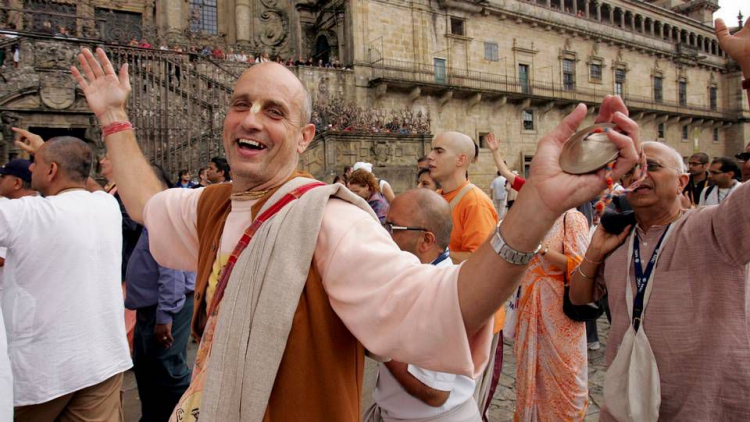Why Does Devotion Need to be Exhibited in Public?
By Chaitanya Charan Das | Nov 01, 2013

Devotion is an emotion of the heart; why does it need to be exhibited publically, as in street kirtans?
Devotion is not just an emotion of the heart; it is also the destination of life itself. Gita wisdom explains that we are eternal souls whose topmost destiny is an everlasting life of love with Krishna in his supreme abode. What defines that abode is devotion; everyone there is purely devoted to Krishna. What propels our journey to that abode is the growth of devotion into the most prominent and dominant emotion of our heart.
Service as the vehicle of devotion
Devotion, like any other emotion, is real only when it is expressed. Imagine a mother who claims to love her baby but doesn’t do anything when the toddler starts crying. Would we consider her claims of love for the baby real? Unlikely. In fact, we could be forgiven if we started doubting whether she was the real mother of the baby.
Similarly, our devotion is real only when we express it through service to Krishna. Anybody can claim to possess devotion in the heart and many people do. It is the regular rendering of service that separates authentic devotion from the shallow- or pseudo-devotion, just as it would separate authentic motherly love from its shadows.
We might object: “Krishna resides in our heart and already knows whether our devotion is real or not. So why do we need to express it?”
Because Krishna’s world of love is accessed and relished only by those who express their love through service. In the spiritual world Krishna’s pure devotees strive to serve him in multifarious ways. Through the rendering of service and the resulting reciprocation of affection, both the devotees and Krishna savor the joys of divine love more. The spiritual world would be a very dry and boring place if no one expressed their emotions at all. Without the heart-warming dynamism of service, it wouldn’t be much of an inviting place, certainly not a place that we would like to make our home eternally. It would be more like an office filled with poker-faced and tight-lipped people, a place that we would want to leave as soon as possible for more pleasant alternatives. In fact, it is because many people have such bleak notions of the kingdom of God that they don’t strive to return there.
As aspiring devotees, we don’t have the same oceanic devotional emotions that the residents of the spiritual world have. But we do have drops of devotion and we express those drops through the various services that we do.
Another objection might be, “When devotional service is done publically, might it not degenerate into a public performance meant to garner prestige in a pious culture that exalts such activities?”
That is surely a possible pitfall. If we chant only in public, then such chanting might be called exhibitionism. That’s why Vedic wisdom urges us to chant at every possible opportunity – in public and in private. We can infer that those who chant as a rigid discipline both in private and in public are expressing authentic devotion.
The public performance of devotional activities has an additional point in its favor: its benefits are not restricted to the participants alone. For example, public kirtans also benefit the onlookers whose dormant devotion is stirred by these spiritual stimuli.
Thus, service is the vehicle through which we express our love for Krishna.
Service as the engine of devotion
Service not only expresses whatever devotion is present in our heart; it also kindles more devotion.
Vedic wisdom explains that love for Krishna is not something that we import from outside, as is the case with love for any worldly person. Krishna is our innermost lover whom we have temporarily forgotten, whereas any worldly person is an external lover whom we temporarily love for at the most a brief lifetime. The process of bhakti-yoga offers us appropriate spiritual stimuli to awaken our devotion, just as therapy for amnesia offers stimuli that prompt recollection.
Engaging in practical devotional service is one of the most potent spiritual stimuli. It arouses our devotion both internally and externally. Internally, it purifies our heart, extirpating immoral and anti-devotional emotions from there and excavating pure devotional emotions. Externally, it exposes us to a cultural atmosphere that reminds us of our long-forgotten life of devotional love. More importantly, it enables us to do many of the activities that the residents of the spiritual world do eternally, that we ourselves were doing a long, long time ago. These activities act as powerful memory-stimulants, thereby accelerating the process of devotional recovery.
The more our devotion is revived, the more we can experience the unlimited happiness that awaits us when we become reinstated in Krishna’s world of love. And each one of these experiences prods us to keep moving along the journey back to Krishna. Thus, our performance of service and the subsequent experiences of devotional fulfillment act as the engine for our journey back to Krishna.
Seated in the vehicle of service and powered by the engine of service, we can steadily, even swiftly, propel our devotion to its full potential. No wonder then that the Gita pairs its description of devotion with its prescription for service. The Gita (9.13) describes those whose hearts are filled with devotion, having taken shelter of Krishna. It then (9.14) states that they determinedly (dridha-vratah) engage in various forms of service, including constant chanting of Krishna’s glories (satatam kirtayanto mam).
By following in their footsteps, we too can attain the supreme destination that they have attained.















